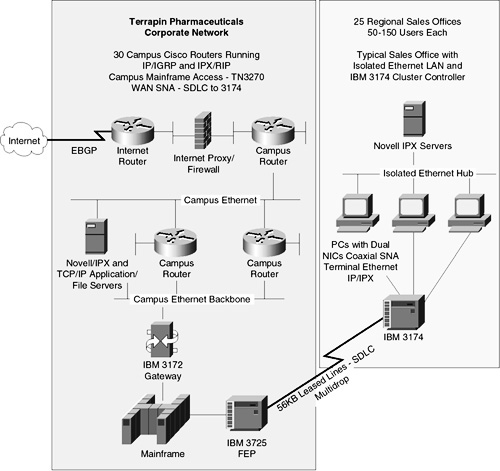Designing Implementing an OSPF Network
OSPF and the Multi-Protocol Router (MPR)I considered long and hard about whether to include this section in the book, and I decided I would. Because it is important to note the extent to which OSPF has been implemented throughout the networking arena. Not too long ago, routers were by default very expensive pieces of hardware that always received the blame for network outages. You are probably aware that the Cisco router is usually very reliable and easy to understand—at least when compared to the competition. Imagine that—reliable and easy to operate, and they are the market leader—seems like Business 101 to me, but I digress. Today routers are relatively inexpensive and self-configuring to a certain degree. It is acknowledged that the IOS is the soul of the router because it examines and makes routing decisions, which the hardware executes. There are now a variety of router manufacturers such as Cisco Systems, Bay Networks, Ascend, 3Com, and many others. However, Novell made a truly astounding move by introducing the Multi-Protocol Router (MPR) as a software service within their NetWare Software Suite. This MPR delivers routing services, and it can operate on any machine that can run NetWare server. Novell’s move indicates a move within networking away from traditional router design. It was not long before Microsoft also offered an MPR within Windows NTv4. Adding this routing ability is an excellent move on their part because it further enhances the usefulness of their operating systems. You can argue all day about the good and bad regarding software routers or specialized routers. Nevertheless, the bottom line for many is economics and being able to use a PC as a router has its appeal. While Cisco and others have many office or campus routers on the market, they still have not recognized the need to make a PC a router, so this market remains the sole property of Novell and Microsoft. To be fair, I should discuss both Microsoft’s and Novell’s MPRs, but this is a book about OSPF networks and only Novell recommends configuring your MPR using the OSPF standard. In this case, it is beyond the scope of this book to discuss Microsoft’s MPR. Sorry Bill, but you should consider OSPF as the default in WIN NTv5. OSPF & Novell’ MPR When configuring OSPF within Novell’s MPR it is important to note that by default OSPF is turned on—they are so smart! The MPR uses the standards for OSPF in its design. It is not as configurable as a normal router but then it was not meant to be. You will find that the MPR has the following configurable options:
Considering that you would likely use an MPR within a stub area, at a very small location not rating a real router, or in case of emergencies, it can be configured surprisingly well. The MPR is not the means to build today’s Enterprise networks but, it certainly should not be discarded out of hand because it does have its place in the grand scheme of networking. It is going to be interesting to see what the future is going to bring us regarding this area of networking. I suggest watching it very closely. Chapter SummaryThis chapter covered the common set of network design goals to ensure that your network is of enterprise quality. There are always some unique issues surrounding every type of network and these were discussed as well. To review, the six steps of designing a network with special emphasis on the areas that are essential to OSPF are as follows:
Answering the question of “how to actually make my Cisco router do all this” was then covered in the “Configuring OSPF on Cisco Routers” section. The overall process of implementing OSPF on your routers as well as the different types of OSPF routers (inter-area, intra-area, ABR, ASBR, and backbone), was discussed. Then, a variety of different scenarios that you might encounter within your network were discussed, as well as how best to implement OSPF to meet these scenarios. The chapter concluded with the “IOS on a PC” or Multi-Protocol Router (MPR) that are beginning to see more wide-spread application within the industry and, of course, they also support OSPF, so their roles as they relate to OSPF were discussed. Case Study: Designing an OSPF Frame Relay NetworkTerrapin Pharmaceuticals has 25 regional sales offices dispersed throughout the eastern United States. The main corporate headquarters and the data center for Terrapin Pharmaceuticals is located in Tennessee. The following list details some of the network attributes of the Terrapin Pharmaceuticals setup.
Figure 7-25 shows the existing Terrapin Pharmaceutical network.
|
EAN: 2147483647
Pages: 200
